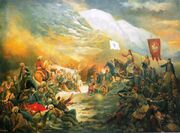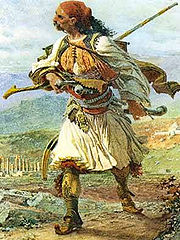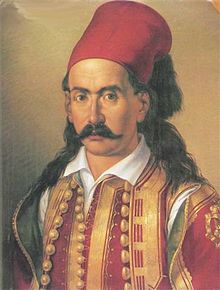Markos Botsaris (Greek: Μάρκος Μπότσαρης, 21 August 1788 – 22 April 1827) was a general and hero of the Greek War of Independence. Markos is among the most revered national heroes in Greece.
Markos is most well known for his heroic defense of Missolonghi and his victorious campaign in Rumeli in 1826-1827, where, in three months, he had managed to retake Rumeli from the Turks.
Early Life[]
Markos Botsaris was born into one of the leading clans of the Souliotes, in Epirus. He was the second son of captain Kitsos Botsaris, who was murdered in Arta in 1809 under the orders of Ali Pasha. The Botsaris clan came from the village of Dragani (today Ambelia), near Paramythia. In 1803, after the capture of Souli by Ali Pasha, Markos crossed over to the Ionian Islands. At that time, the Ionian Islands were a Russian puppet state. But after Russia's defeat by Napoleon in 1807, the French took over the Ionian Islands, which became a battlefield between the British and the Napoleon's Imperial French.
In the Ionian Islands[]
In 1809, Markos joined the British Army and soon became a Major, commanding the Greek regiment of the British army. Markos took part in the takeover of Lefkada, which took place in 1810. The British General Osvald wanted to make a night landing in Lefkada, which Markos objected:
"General, we should not make a landing [in the night], because we are from many places and we do not know each other and we could kill each other [by accident]. But, if we land in the morning, I can promise that by noon, we would taken over the country [Lefkada]."
Indeed, the British army was able to make a successful landing in Lefkada in the morning and defeat the French army. The Greeks, encouraged by their first victories, then marched against the French Fort. But, when the French cannons fired from the Fort, Markos shouted Get down, dogs!!. So, the cannon fire found the British and Corsicans who were marching behind the Greeks, causing much death. The Greeks had 35 dead and injured, while the British and the Corsicans lost large numbers of men. Markos then shouted again and the Greeks run and took over the Fort.
Revolutionary[]
In 1814, Markos joined the Greek patriotic society known as the Filiki Eteria. In 1821, Markos took part in the revolution against the Ottoman Empire. At the outbreak of the Greek War of Independence, he distinguished himself by his courage, tenacity and skill as a partisan leader in the fighting in western Greece.
First Successes[]

The Revolutionary Flag that Markos used.
In early 1822, he was made General of Western Central Greece and was conspicuous in the defence of Missolonghi during the first siege of the city (1822–1823). On the night of 21 August 1823 he led the celebrated attack on Karpenisi by 350 Souliots, against around 1,000 Ottoman troops who formed the vanguard of the army with which Mustai Pasha, the Ottoman Albanian Pasha of Shkoder, was advancing to reinforce the besiegers. Markos was able to ambush the Ottoman troops, killing 600 of them and losing only 40 men.
In October 1823, Markos led a force of Souliots and Roumeliots in the Peloponnese, and fought alongside the government of Georgios Kountouriotis against the rebels in the civil war. In March 1825, after the Peloponnese had been invaded by Egyptian forces, he was appointed politarch (head of public order) of Kyparissia and took part in the defence of Neokastro. After the fortress fell on 11 May 1825, he hurried to Myloi, near Nafplio, arriving with one hundred men on 10 June. He ordered the construction of makeshift fortifications, as well as the gathering of provisions. More chieftains soon arrived in Myloi and Ibrahim Pasha, the commander of the Egyptian forces, was unable to take the position, despite numerical superiority and the launching of fierce attacks on 12 and 14 June.
Rumeliot Campaign[]

The Battle of Arachova.

Greek Soldier.
After the fall of Missolonghi in 10 April 1826, most of Rumeli came under the control of the Ottoman Turks and the provinces there surrendered to the Turks, except for Athens and a few surrounding areas. This was of course bad for the Greek rebels, who if they wanted to have any chance of being recognized by the European States had to gain victories on the battlefield.
In August 1826, the Ottoman Turks, under the leadership of Reşid Mehmed Pasha begun the siege of Athens with 10,000 troops with strong cavalry and artillery. Of course, the Greeks could not accept the fall of Athens, because they claimed Rumeli to be part of their state and if they lost Athens, the Greek State would be limited to the Peloponnese and the philhellenes could not accept the fall of Athens, the fall of democracy and freedom to Asian Barbarism. Athens was the symbol of freedom, democracy and classical Greece for the Europeans.
So Markos was given the almost impossible task of forcing Resid Pasha to end the siege and restore the revolution in Rumeli, with force if needed. This was a daunting task. First of all, the Rumeliots in the Peloponnese were afraid that the Peloponnesians would make peace with the Ottomans and give Rumeli to the Turks and kick them out of the Peloponnese. So they wanted more to gain control of the capital, Nafplion, than go to fight the Turks.
Markos managed to persuade them to join him and begin a campaign in Rumeli. Markos asked the government only for supplies and ammunition. There were no money for wages, but the fame of Markos as an able leader who could gain victory (and victory meant looting) made many to come and join him.
But the Rumeliots who joined him were still only a few hundred. He made a temporary military camp in Salamis and then gathered the troops who were still in Rumeli in Eleusina. He had only 4,000 troops compared to the 10,000 Turks and had only a small area under his control.
Markos then tried to get to a closer position to Athens and clashed with the Turkish forces in Chaidari from 6 to 8 August, although the battle ended in stalemate with many deaths in both sides. Markos then took the decision to begin a campaign in Rumeli (north of Athens) to cut off the land supply rout of Resid Pasha and also force the Rumeliot provinces to rise up in revolt. So in 25 October 1826, he begun his Rumeliot campaign. He left 2,000 troops back to Eleusina and took 2,000 troops with him.
Markos tried to besiege Dombraina in 27 October, but the siege became a stalemate and he left for Distomo in 14 November. Markos' goal was now to secure the area around Parnassos from Arachova. So, in 17 November he set up camp in Distomo and send a small force to take over Arachova, which it did.
Then an Ottoman Force, 2,000 strong, under Mustafa Bey moved against Arachova in order to retake the city. The garrison of the city was 500 men strong. Markos moved fast to help the city. The attack on Arachova begun in 18 November. Althought the Turks at first had some success, Markos attacked the Turkish army from the rear, forcing them to retreat to a hill in the opposite of the church of Saint George, which Markos made his headquarters.
Meanwhile reinforcements came to help the Greeks and the next days the bad weather and the lack of supplies crippled the Ottomans, who asked for a ceasefire in 21 November. However, the Ottomans refused to surrender Livadeia and Salona to the Greeks, and so their request for a ceasefire was refused.
In 23 November, after bloody fighting, Mustafa Bey was killed. The next day, in 24 November, the Turks tried to retreat, but all routes were under Greek control. So the Turks were literally slaughtered and the few who survived died because of the cold and snow. Only 300 to 200 Turks from a force of 2,000 survived. The Greeks lost only 24 men. Also 60 were injured.
Under orders from Markos, the Greeks cut the heads of Mustafa Bey and other 300 Turks and created a Pyramid with their heads, which Markos named "Trophy of the Greeks from the Barbarians". The message was clear to both the Turks and the provinces in Rumeli that did not rise up in revolt.
Now, with almost all of Rumeli under Greek control, Markos could harass the Ottoman supply lines. In 7 December, when he learnt that a Turkish supply line with more than 2000 transport animals and guarded by 500 cavalrymen was coming, he laid ambush in Kallidromos. His attack was a huge success and the looting gave many riches to the soldiers.
Three days later, he left a portion of his army in Tithorea and moved to Ypati, but bad weather forced him to return back to Arachova. At the same time, 1,500 Turks came from Missolonghi to help the garrison of Salona. This led Markos to move part of his army in Naupactus, where they stopped the Ottoman reinforcements.
In 17 January 1827, Omer Pasha attacked Distomo with 2,500 troops, but he failed to take the city. So, in 21 January, Markos with 400 troops conducted a night raid of the Turkish camp, causing panic and death to the Turks. In 31 January, 800 Turks of the new Tactical Ottoman Army (created after the abolishment and purge of the Janissaries) attacked the Greek positions in Distomo, defeating the Greeks and causing panic that almost killed Markos himself (who always fought along with his troops in the first line).
But in a second battle in 3 February, the Greeks defeated and routed the Ottoman Tactical Army. In 5 February, Markos conducted a surprise night attack on the camp of Omer Pasha, this time causing so damage that Omer had to retreat. Three months after Markos had begun his campaign, most of Rumeli was under Greek control and Resid Pasha had problems with his supplies.
This was the first time the Greeks managed to gain a major victory since 1825. The victories of Markos gave hope to the Greeks that they could win the Turks. Markos' prestige went on new heights and he gained the reputation of a great military commander. In 25 February he returned with 1,000 troops back to Eleusina.
Death[]
In Athens, Markos favoured a cautious approach of the Turkish lines, by building Forts before moving closer to each Turkish line. But the Commander of the Greek Forces, the english admiral Thomas Cochrane, wanted an all out attack against the Turks, despite the protests of Markos.
The day before the all out attack, in 22 April, a small skirmish between Greek and Turkish forces begun, which became a full scale battle. When Markos, riding his horse, went to see what was happening, he was shot (no one knows by who. Some say by the Turks, others by friendly fire and others that the British had him killed) and died. In 24 May Athens surrendered to the Turks. Markos is now remembered in Greece as a national hero.
